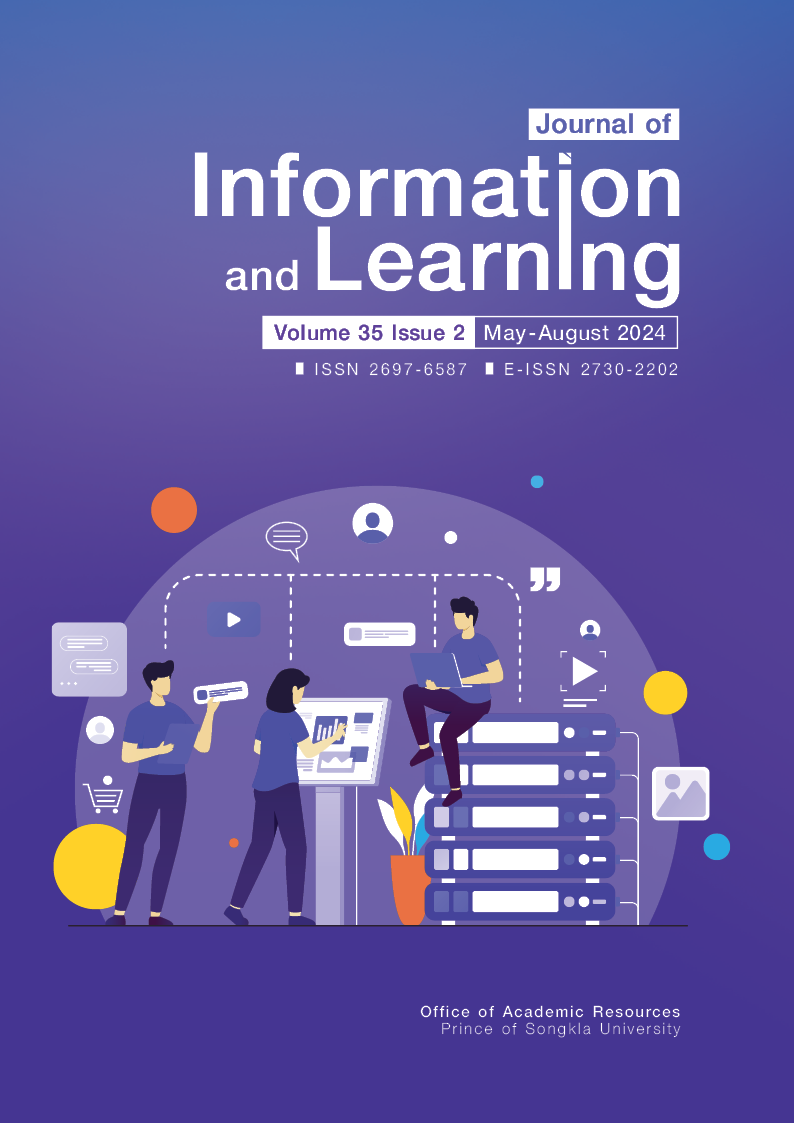Analysis and Classification of Knowledge About the Settlement of Ethnic Groups in Lanna
Main Article Content
Abstract
The objectives of this research were to analyze and classify the knowledge groups of the settlements of ethnic groups in Lanna using qualitative research methods. The tools used to collect data included an analysis form for the settlement of ethnic groups in Lanna and information resources containing content related to the settlement of ethnic groups in Lanna, a total of 311 items from 17 information sources.
The research findings revealed that knowledge grouping of the settlements of ethnic groups in Lanna could be classified into 17 classes. After considering content redundancy, the groups remained in the 17 classes. To ensure the accuracy, comprehensiveness, and completeness of the knowledge groups about the settlement of ethnic groups in Lanna, they were rechecked by three experts in classification. Based on their evaluation of the knowledge grouping of settlements of ethnic groups in Lanna, it was capable of being used as a source of knowledge about the settlements of ethnic groups in Lanna and could be finalized into 17 main classes. The main classes included settlement, occupation, language, clothing, housing, family, beliefs, religion, way of life and traditions, religious rituals, medicine (12) food (13) governance, education, characteristics, music, and games. It was classified into 65 sub-classes, 75 divisions, 352 sub-divisions I, and 59 sub-divisions II.
Article Details

This work is licensed under a Creative Commons Attribution-NonCommercial-NoDerivatives 4.0 International License.
The Journal of Information and Learning is operated by the Office of Academic Resources, Prince of Songkla University. All articles published in the journal are protected by Thailand copyright law. This copyright covers the exclusive rights to share, reproduce and distribute the article, including in electronic forms, reprints, translations, photographic reproductions, or similar. Authors own copyrights in the works they have created as well as the Office of Academic Resources. The Journal reserves the right to edit the language of papers accepted for publication for clarity and correctness, as well as to make formal changes to ensure compliance with the journal's guidelines. All authors must take public responsibility for the content of their paper.
References
Broughton, V. (2017). Faceted classification as the basis of all information retrieval. Ucl.ac.uk. https://discovery.ucl.ac.uk/id/eprint/10038742/3/Broughton_final_Faceted%20classification.pdf
Buruspat, S. (1998). Encyclopedia of Thai Soong ethnic groups. Southeast Asian Language and Culture Research Office Language and Culture Research Institute for Rural Development Mahidol University, Salaya.
Chaikhambung, J., & Tuamsuk, K. (2017). Knowledge classification on ethnic groups in Thailand. Cataloging & Classification Quarterly, 55(2), 89-104. https://doi.org/10.1080/01639374.2016.1271074
Chaipikusit, P. (1999). Twelve tribes in Thailand: Unique cultural traditions. Sri Soda Temple Foundation.
Chansanam, W., Chotkamonsawad, P., & Nguyen, L. T. (2023). Developing a knowledge organization system for ethnic groups in Lao PDR through Linked open data techniques. Journal of the Australian Library and Information Association, 73(1), 1-14. https://doi.org/10.1080/24750158.2023.2275096
Chansanam, W., Kwiecien, K., Buranarach, M., & Tuamsuk, K. (2021). A digital thesaurus of ethnic groups in the Mekong River Basin. Informatics, 8(3), 50. https://doi.org/10.3390/informatics8030050
Highland Research and Development Institute. (2011). In-depth population data for highland areas in 20 provinces. Highland Research and Development Institute. https://web2012.hrdi.or.th/about_us/page/about
Kāntangthinthānkhō̜ngmanut [Human settlement]. (2016). Kanittha’s Blog. https://ajkanittha.files.wordpress.com/2016/06/unit-2.pdf
Kasethet, B. (2019). Rākngao phaophan nai Sayām [Roots of races in Siam]. Inthanin.
Kumar, K. (2020). Theory of classification. Vikas Publishing House. Manutkapsingwǣtlǭm [Humans and the environment]. Kanittha's Blog. https://ajkanittha.files.wordpress.com/2016/06/unit-11-e0b8a1e0b899e0b8b8e0b8a9e0b8a2e0b98ce0b881e0b8b1e0b89ae0b8aae0b8b4e0b988e0b887e0b981e0b8a7e0b894e0b8a5e0b989e0b8ade0b8a1-edit.pdf
Matamanda, R. A. (2019). Exploring emerging human settlement forms and urban dilemmas nexus: Challenges and insights from Hopley Farm, Harare, Zimbabwe [Doctoral dissertation, University of the Free State]. https://scholar.ufs.ac.za/server/api/core/bitstreams/2e68f46f-36c9-44c3-9266-b9141c885064/content
Matanbun, W., Jinachan, T., Lekkomboon, K., & Champawan, A. S. (2013). Thaiphư̄nrāpnailānnā [Plains Tai ethnic group in Lanna]. Social Research Institute, Chiang Mai University.
Ministry of Social Development and Human Security. (2015). Phǣnmǣbotkānphatthanāklumnaiprathedthai (2558-2560) [Master plan for the development of ethnic groups in Thailand (2015-2017)]. Ministry of Social Development and Human Security.
Muanchanchuey, R. (2005). Encyclopedia of ethnic groups in Thailand: Thai Yuan. Language and Culture Research Institute for Rural Development Mahidol University.
Office of the Health Promotion Foundation. (2023). Phư̄nthī khumkhrō̜ng withī chīwit klum chāttiphan kap kān songsœ̄m suk phāwa klum chāttiphan [An area to protect the lifestyle of ethnic groups and promote the health of ethnic groups]. Thaihealth. https://section09.thaihealth.or.th/wp-content/uploads/sites/26/2023/02/
Ongsakul, S. (2018). Lanna history. Amarin Group.
Phonphotthanamat, W. (2022). A comparative study of verifying the content validity of a research instrument with the IOC, CVR and CVI. RSU Library Journal, 28(1), 169-192. https://rilj.rsu.ac.th/journal/57/article/281
Premsrirat, S. (1998). Encyclopedia of Khmu ethnic groups. Southeast Asian Language and Culture Research Office Language and Culture Research Institute for Rural Development Mahidol University.
Premsrirat, S. (1994). Phonetic variation of final trill and final palatals in Khmer dialects of Thailand. Mon-Khmer Studies Journal, 24, 1-26. http://www.mksjournal.org/archives/mks/pdf/24:1-26.pdf
Sirindhorn Anthropology Center. (2023). Klumchātiphạnṭhu nai prathed thai [Ethnic groups in Thailand]. Sac.or.th. https://ethnicity.sac.or.th/database-ethnic/193/h
Sirisai, S. (1996). Encyclopedia of the Lahu ethnic group. Language and Culture Research Institute for Rural Development Mahidol University.
Sodsongkrit, M. (2013). Kānsưksā thāng phāsāsāt chœ̄ng prawatsāt rư̄ang khwāmsamphan khō̜ng phāsā thai thin ʻīsān kap phāsā čhīn [Historical linguistic study on Relationship of the Isan dialect of Thai with the Chinese language]. Ubon Ratchathani University.
Suebsaeng, N. (1996). Khmu society and culture and development. Hilltribe Research Institute.
Suebsonthi, P. (1987). Kānwičhaibannāraksasātlæsāranithētsāt [Library and information science research]. Chulalongkorn University.
Sukcharoen, N. (2022). Kān tang thin thān læ kān yāi thin [Settlement and migration]. Distance Learning Television. https://www.dltv.ac.th/utils/files/download/30694
Suthinirunkul, C. (2002). Analysis of biographical books of Thai people published during 1981-2000 [Unpublished master's thesis]. Chulalongkorn University.
Thummasena, A.. (2021, November 10). Klum chāttiphan mai chai khon ʻư̄n [Ethnic groups are not "others”]. The Active. https://theactive.net/read/the-indigenous-peoples-of-thailand
Tosarat, N., & Meesathan, A. W. (1997). Encyclopedia of Mien (Yao) ethnic groups. Southeast Asian Language and Culture Research Office Language and Culture Research Institute for Rural Development, Mahidol University, Salaya.
Yimrewat, P., & Rattanakul, S. (1998). Encyclopedia of the Lua ethnic group. Southeast Asian Language and Culture Research Office Language and Culture Research Institute for Rural Development Mahidol University.


